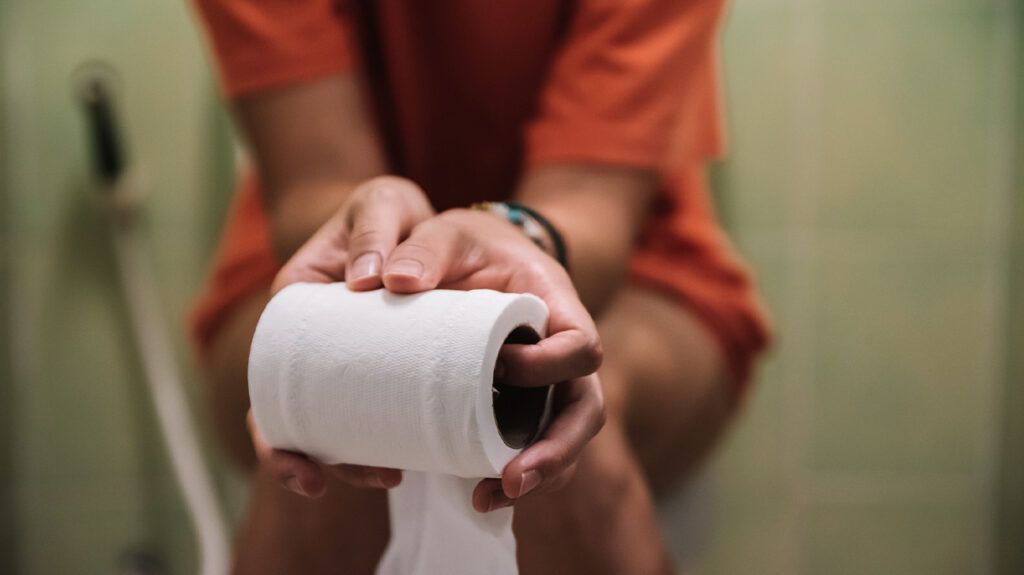What a person’s stool, or poop, looks like can be a good indication of their digestive health. While it may be an embarrassing topic, a person should pay attention to the appearance of their stool and make a note of any changes.
Variations in the color of a person’s stool can indicate a medical condition that doctors may need to investigate and treat. Orange poop is often a sign a person should change something in their diet.

Diet is a common reason for a person’s stool to be orange.
Foods
Any food or drink with a distinctive color can change the color of a person’s poop.
For example, eating a lot of blueberries or drinking soda containing blue dye can make the stool appear blue.
When a person’s poop is orange, it could be due to consuming excess beta-carotene, an orange pigment found in fruits and vegetables.
Foods high in beta-carotene include:
- carrots
- sweet potato
- squash
- mangoes
- apricots
- pumpkin
- leafy greens
- some herbs and spices, such as paprika, cayenne, chilli, sage, and coriander
Foods and drinks that contain artificial dye can also make poop appear orange. These dyes may be yellow, orange, or red.
Products that often contain artificial dye include:
- candies
- soda
- popsicles
Consuming escolar, a fish that lives in tropical waters, can also make a person’s stool orange. This is because the fish contains an indigestible fat that is released into the bowel and affects the color of a person’s waste.
Digestive problems
Certain digestive issues can also cause a change in stool color, usually making it appear pale, green, black, or red.
One condition that affects the lining of the esophagus and stomach is acid reflux.
When the condition occurs long-term, it is known as gastroesophageal reflux disease (GERD). GERD occurs when the stomach contents repeatedly move back into the esophagus, causing inflammation and damage.
This condition causes a person to experience heartburn and can change the color of a person’s stool. GERD can cause yellow stool because food moves quickly through the intestinal tract.
GERD is also associated with several other symptoms, including:
- belching
- nausea and vomiting
- a chronic cough and wheezing
- a sore throat, hoarseness, or change in voice
- difficulty swallowing
- chest pain
- sour taste in the mouth
Medications and scans
Beta-carotene is in some supplements and medications, which can make poop orange in color.
Also, having an imaging scan that involves injecting a dye, such as an MRI, CT, or PET, can also change stool color temporarily.
Healthy bowel movements typically produce brown stools. Common color changes that can indicate a problem include:
- Red: Blood smears when wiping could be a sign of hemorrhoids or an anal tear, known as a fissure. Bright red blood or maroon blood in the stool could signify internal bleeding.
- Black: A black stool may indicate excess iron consumption. However, bleeding from the esophagus, stomach, or an ulcer can also make poop look black.
- Cream or light-colored: A pale stool may indicate that bile salts are absent. This deficiency could be due to conditions that affect the pancreas, gallbladder, or liver.
- Green: Green stools commonly occur due to conditions that cause diarrhea or a diet rich in leafy greens or heavy in artificial coloring.
A person’s diet and medication can also affect the color of their stool.
Treatment for orange poop will depend on the cause. A color change in a person’s stool does not necessarily indicate a serious problem, but it is important to monitor it closely. People should seek medical advice if they have any concerns.
Diet
If a person notices their poop is suddenly orange, they should consider the food they have eaten that day or the day before.
If they have consumed an excessive amount of beta-carotene or artificial dye, limiting the intake of these foods and drinks could stop the problem.
Some people report sensitivities to certain artificial dyes, so restricting their consumption of foods and beverages containing these substances may be beneficial.
Read about foods to eat and avoid with GERD.
GERD
If a person has GERD, treatment aims to reduce acid reflux, reduce stomach acid, improve digestion, and protect the esophagus.
Treatment will depend on the severity of the condition. For some people, lifestyle changes can decrease episodes of acid reflux.
Changes that may help some people include:
- not lying down for at least 2 hours after meals
- standing up and walking around after eating to help gastric juices to flow in the right direction
- not overeating
- limiting alcohol, chocolate, or caffeine
- restricting fatty, salty, or spicy foods
- losing weight if necessary
- quitting smoking
- changing medications that cause symptoms
- raising the head of the bed by around 6 inches
- eating dinner at least 3–4 hours before bed
In more serious cases, medications or surgery may be necessary.
Read about ways to ease GERD symptoms at home.
If a person continues to have orange poop despite lifestyle and dietary changes, then it could be a sign of an underlying health problem.
A doctor may recommend stool analysis and blood tests to determine the cause.
Other reasons to talk with a doctor include persistent changes in stool texture, shape, and frequency.
Orange poop could have causes, including consuming large amounts of beta carotene in foods, beverages, or supplements, digestive issues, such as GERD, and having imaging scans that use contrast dye.
If limiting beta carotene intake and making lifestyle adjustments to manage GERD are ineffective, people should discuss their orange poop with a doctor.
People should also contact a doctor if they have persistent changes in the texture, shape, and frequency of their poop.
